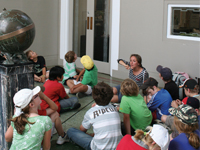
It is the chance to teach students about the culture and heritage of the Wellington region, and the part it has played in developing New Zealand society, which has led to the recent redevelopment of the Petone Settlers Museum.
Situated on the Petone foreshore, the museum has had a number of incarnations in its 70-year history – from its early life as a memorial to commemorate the arrival of the first British settlers in Wellington, to becoming the main changing rooms for the foreshore.
The museum has recently reopened with a revamped interior and a more fluid design, providing a fresh new look for the building and expanding on the important stories it has to tell.
Andy Glanville, the museum’s learning programmes manager, says the refurbishment has seen the museum go from having two disparate wings – one telling the story of the first English settlers arriving in Wellington Harbour, and the other housing constantly changing exhibitions – to a more fluid retelling of the settlement story.
“The upgrade broadens the settlement story and expands it to take in the history of the harbour from Maori right through to the arrival of the English. It has become more a story of settlement through the ages,” he says.
The development has held on to the essential character of the building and has kept the charm of the original museum.
“We’ve kept the models and dioramas that young people tend to respond to,” explains Glanville. “These really open up history for many students and give the subjects added visual impact.”
And it’s that impact, and the ability of Glanville and his colleague, Jen Boland, to bring history alive, that makes the museum so popular with visiting school groups of all ages.
“We both enjoy dressing up in costumes from the 1840s, similar to what the first English settlers would have worn,” says Glanville. “This helps to create an authentic context to the exhibits for visiting students.
“Museums are about bringing things to life and helping students make those connections, by seeing the models, holding the artefacts, being shown around by people in period costume, and looking at dioramas that show the way of life,” he says.
The museum’s free educational programme caters for each year level, from new entrants through to senior secondary school students.
“The idea is that each year students will return and find out a bit more about the story – a bit like the chapters in a book,” says Glanville.
The museum’s educational programme for new entrants, ‘Korero’, focuses on oral traditions, the formation of Te Whanganui-A-Tara and stories of the Taniwha. “With the museum situated right on the foreshore, during terms one and four we utilise the beach and create Taniwha in the sand,” says Glanville. “The idea for this programme came from a successful school holiday programme activity in which we made sand sculptures.”
Programmes for older students encompass additional curriculum areas and include: ‘Comparing the Past with the Present’, a technology-based look at how transport, toys, and roles and responsibilities have changed since 1840; ‘Tangata Whenua’, a programme examining how the Maori farmed, fished, hunted and lived prior to the arrival of the English; and ‘A New Land,’ which takes students through the settlers story – exploring what the land was like when they arrived and what it was like arriving in a strange new land.
“The programmes can be used to fill in the gaps between what can be learnt in the classroom and externally,” says Glanville. “They are designed to spark an interest and build on what’s being taught in schools.” And it is expected the new educational programmes will also spark an increase in educational visitors.
Glanville says, “We’re really excited about the reopening. We’re excited about what we can offer young people and teachers, and we’ll go the extra mile in creating a memorable experience.”
Bullying contributes to poor wellbeing and absenteeism in New Zealand. Discover how you can address…
Free school lunches will continue under a modified model which will reportedly see $107 million…
A new interactive website showing daily attendance figures was launched last week as part of…
Two reviews of early literacy approaches and an accompanying Ministry of Education commentary show promising…
We must have bipartisan decision-making for education, says academics Bronwyn E. Wood and Taylor Hughson…
The OECD’s new report makes several policy recommendations for our education sector in the hopes…
This website uses cookies.